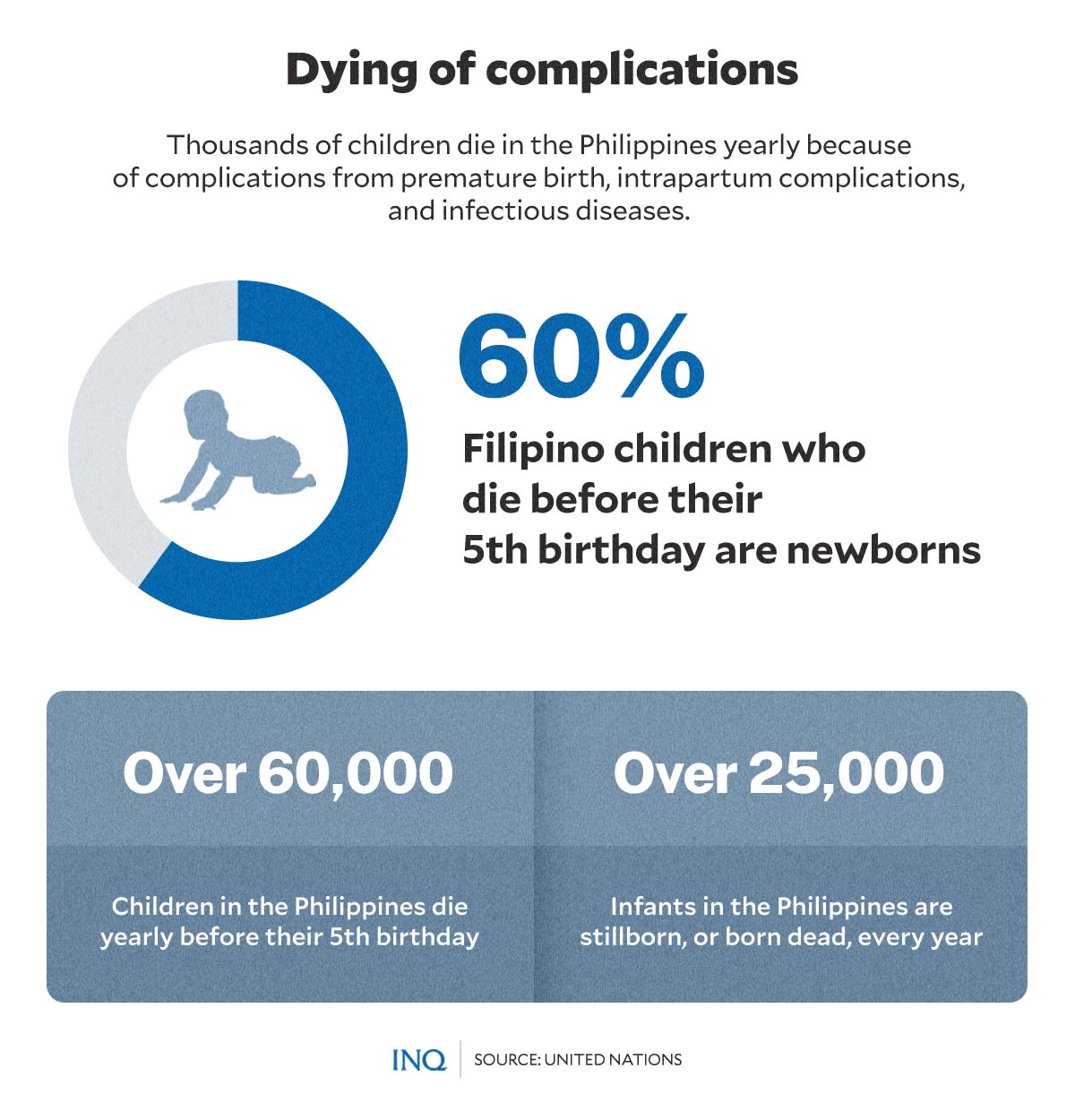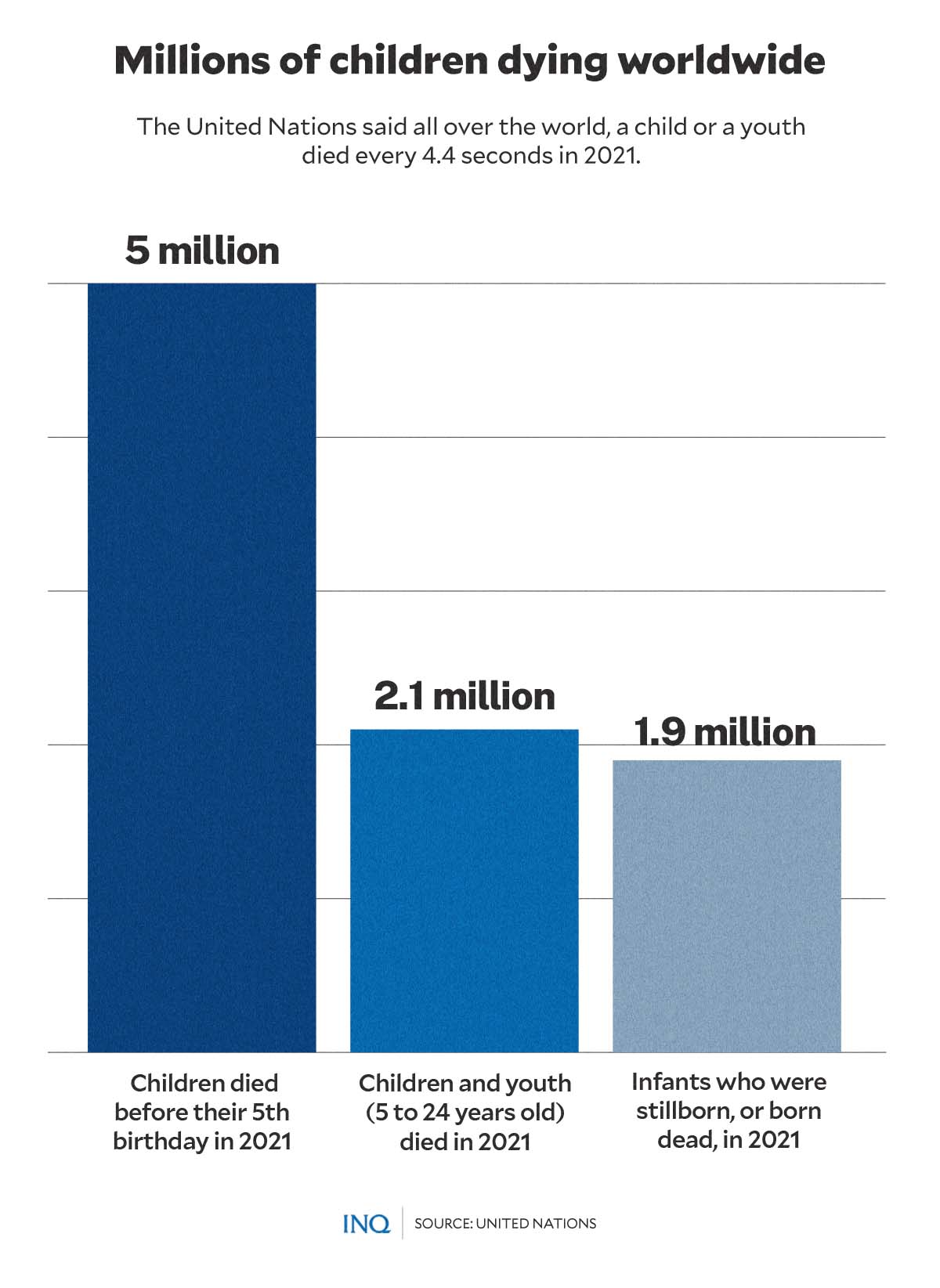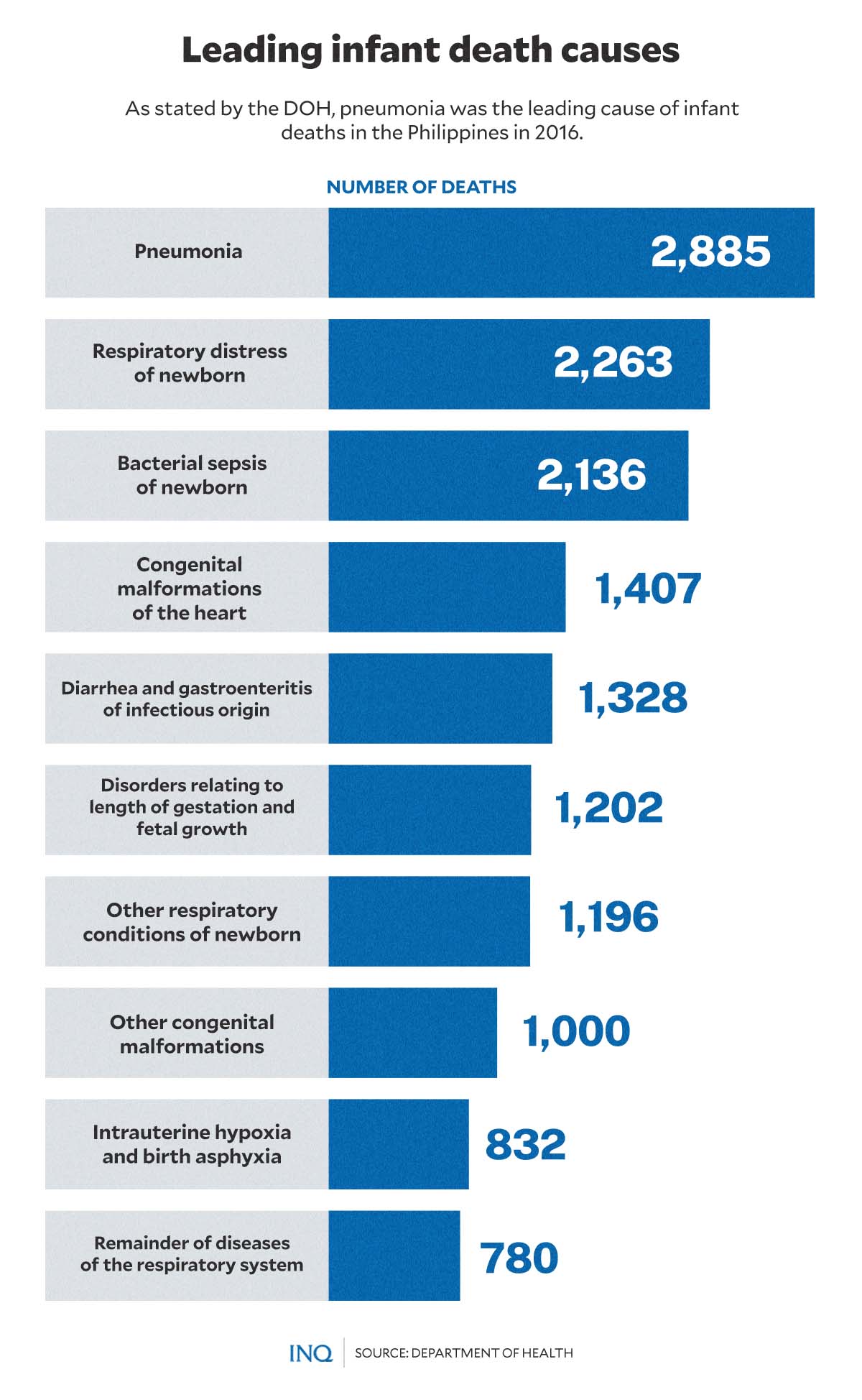Preventable: 60,000 PH children die per year before 5th birthday
MANILA, Philippines—“Every day, far too many parents are facing the trauma of losing their children, sometimes even before their first breath.”
It’s really heartbreaking, isn’t it?
But according to Vidhya Ganesh, director of the Data Analytics, Planning and Monitoring Division of the United Nations Children’s Fund (Unicef), it is the reality for some.
She said this as the United Nations Inter-Agency Group for Child Mortality Estimation (UN IGME) revealed that all over the world, at least five million children died before their fifth birthday, while 1.9 million infants were stillborn, or born dead, in 2021.
In the Philippines, over 60,000 children die yearly before their fifth birthday because of complications from premature birth, intrapartum complications, and infectious diseases. Over 25,000 are stillborn every year.
Article continues after this advertisementAlmost 60 percent of the 60,000 are newborns, the UN IGME said, stressing that this “points to a need to improve health and nutrition outcomes for both mothers and babies.”
Article continues after this advertisementThe latest UN report stated that “the Philippines needs to increase access to quality maternal and child health and nutrition services, achieve full vaccination of all children, and deliver on commitments for ensuring good health and nutrition through the first 1,000 days of life.”
With these, “children will not only survive, but thrive,” the UN IGME said.
What’s killing babies?
According to the latest data from the World Health Organization (WHO), infectious diseases, like pneumonia, diarrhea, and malaria, remained to be the leading cause of death for children younger than five years old.
Birth complications, birth asphyxia, and congenital anomalies were also listed by WHO as one of the top causes of infant deaths all over the world in 2020, when almost five million children—2.4 million newborns—died before their fifth birthday.
According to the latest data from the Department of Health, pneumonia, which killed 2,885 children, was the leading cause of infant deaths in the Philippines in 2016.
Next to pneumonia were respiratory distress of newborn (2,263 deaths), bacterial sepsis of newborn (2,36 deaths), congenital malformations of the heart (1,407 deaths), and diarrhea and gastroenteritis of infectious origin (1,328 deaths).
The DOH said in its 2016 Philippine Health Statistics that disorders relating to length of gestation and fetal growth were also among the leading causes of infant mortality in the country with 1,202 deaths.
The rest were other respiratory conditions of newborn (1,196 deaths), other congenital malformations (1,000 deaths), intrauterine hypoxia and birth asphyxia (832 deaths), and the remainder of diseases of the respiratory system (780 deaths).
‘Preventable deaths’
But according to WHO, most of the leading causes of deaths, like pneumonia, diarrhea, birth complications and birth asphyxia “can be prevented or treated with access to affordable interventions in health and sanitation.”
As Gayesh said, “such widespread, preventable tragedy should never be accepted as inevitable.”
“Progress is possible with stronger political will and targeted investment in equitable access to primary health care for every woman and child,” she said in a statement released by Unicef on Friday (Jan. 13).
Take the case of the Philippines.
It was only last year when the Commission on Population and Development (PopCom) revealed that direct newborn deaths, or deaths caused by certain conditions originating in the perinatal period, are still high—4,424 and 3,686 in the first six months of 2021 and 2022.
READ: PSA logs higher infant mortality rate; Popcom says it’s due to lack of healthcare access
Likewise, it said direct obstetric deaths or direct maternal deaths—those resulting from obstetric complications from pregnancy and from interventions, omissions, or wrong treatment—are rising with at least 468 deaths documented in the first half of 2022.
Back then, no less than PopCom executive director Lolito Tacardon told ANC that “reasons [for this] could be the delay in referral, and in general, the quality of the services being provided in the health facility.”
According to the commission, “the increasing rate of their mortalities in the past two years has been indicative of the difficulties in obtaining services related to maternal and newborn health.”
This, it said, “have produced fatal consequences” and is now prompting the government to provide enough medical attention to mothers and their newborns, especially in infants’ first 1,000 days alive.
Problem rooted in inequality
Based on data from the National Demographic and Health Survey (NDHS), more than half of 15 to 49-year-old women have at least one problem in accessing health care for them and their children, and the most common—45 percent—was “getting money for treatment.”
It was revealed that while nine in 10 Filipino women received prenatal care from a skilled provider, like a midwife (50 percent), doctor (39 percent), or nurse (4 percent), three percent received no prenatal care at all.
Likewise, while postnatal care helps prevent complications after childbirth, the NDHS, which was conducted in 2017, stated that nine percent did not have a postnatal check within 41 days after the date of birth.
RELATED STORY: Newborn Screening Week: Preventing infant deaths one test at a time
When it comes to sanitation, which the WHO said can prevent diseases such as diarrhea, the Philippines is also lagging behind, with some 10 million households, or 50.3 million Filipinos, still not having access to safely managed sanitation services.
READ: Cholera, sign of inequity, rising in PH with cases up by 254%
Out of the 50.3 million, some 24 million use limited or unimproved toilets or none at all.
This, even when most diarrheal illnesses spread through food or water contaminated with the bacteria. The source of contamination is usually the feces of an infected person, the United States Centers for Disease Control and Prevention said.
According to WHO, one in 10 people in the Philippines still do not have access to improved water sources, but the government is working to achieve universal coverage for water by 2028.
Act now
According to the UN report, there were some positive outcomes with a lower risk of death across all ages all over the world since 2000.
The global below-five mortality rate fell by 50 percent since the start of the century, while mortality rates in older children and youth dropped by 36 per cent, and the stillbirth rate decreased by 35 percent.
“This can be attributed to more investments in strengthening primary health systems to benefit women, children and young people,” it said.
However, gains have declined significantly since 2010, and 54 countries will fall short of meeting the Sustainable Development Goals target for below-five mortality.
“If swift action is not taken to improve health services, warn the agencies, almost 59 million children and youth will die before 2030, and nearly 16 million babies will be lost to stillbirth,” it said.
Dr. Anshu Banerjee, WHO director for Maternal, Newborn, Child and Adolescent Health and Ageing, said “it is grossly unjust that a child’s chances of survival can be shaped just by their place of birth, and that there are such vast inequities in their access to lifesaving health services.”
“Children everywhere need strong primary health care systems that meet their needs and those of their families, so that—no matter where they are born—they have the best start and hope for the future.”
The UN said access to and availability of quality health care continues to be a matter of life or death for children globally.
“Most child deaths occur in the first five years, of which half are within the very first month of life. For these youngest babies, premature birth and complications during labor are the leading causes of death.”
Similarly, more than 40 percent of stillbirths occur during labor—most of which are preventable when women have access to quality care throughout pregnancy and birth.
For children that survive past their first 28 days, infectious diseases like pneumonia, diarrhea and malaria pose the biggest threat.



